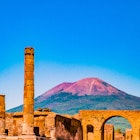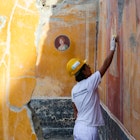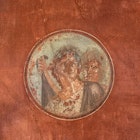
Jan 12, 2023 • 4 min read
Mar 2, 2021 • 1 min read
{
"url": "fresco-casa-ceii-pompeii-restored",
"destination": "Pompeii",
"continent": "Europe",
"country": "Italy",
"region": "Pompeii"
}One of the oldest frescoes in Pompeii has been restored to its colorful former glory, following major restoration works on its decorative elements. The fresco on the back wall of the garden of the House of the Ceii was excavated between 1913 and 1914, and is one of the city's rare ancient domus.
{
"url": "fresco-casa-ceii-pompeii-restored",
"destination": "Pompeii",
"continent": "Europe",
"country": "Italy",
"region": "Pompeii"
}The house is an example of an ancient dwelling of the late Samnite period (2nd century BC). The fresco had faded with time, and its vividness was restored to reveal a hunting scene. It features wild animals alongside Egyptianised landscapes of the Nile Delta depicted on the side walls. Such scenes were not uncommon in the decoration of perimeter walls in Pompeian gardens, and served to create the illusion of expanding the size of the area, and evoking an idyllic and evocative atmosphere.

{
"url": "fresco-casa-ceii-pompeii-restored",
"destination": "Pompeii",
"continent": "Europe",
"country": "Italy",
"region": "Pompeii"
}In this case, the likelihood is that the subject of the painting indicated a specific link and interest on the part of the owner of the domus towards the Egyptian world and the cult of Isis. Ownership has been attributed to the magistrate, Lucius Ceius Secundus, on the basis of a painted electoral inscription found on the exterior of the house. The fresco was cleaned by laser, and the abraded parts of the painting were recovered through careful retouching. Measures were also taken in order to avoid any future infiltration of rainwater and to adequately preserve the area.
The historic house had fallen into disrepair over the years, and the original layout of the house has now been partially recreated. Further information can be found on the Archaeological Park of Pompeii's website here.
Explore an entirely new part of Pompeii for the first time
Pompeii: get to know Italy’s legendary ruined city
{
"url": "fresco-casa-ceii-pompeii-restored",
"destination": "Pompeii",
"continent": "Europe",
"country": "Italy",
"region": "Pompeii"
}
Art and Culture
Visiting Pompeii in 2023? Exciting discoveries reveal new truths about the doomed cityMar 17, 2023 • 6 min read

Jan 12, 2023 • 4 min read

Feb 17, 2022 • 3 min read


Jan 4, 2021 • 2 min read



Apr 24, 2020 • 2 min read

Feb 19, 2020 • 2 min read

Oct 24, 2019 • 2 min read